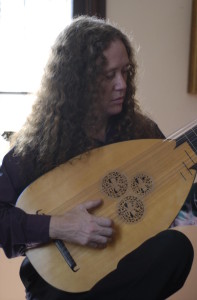
Welcome to the first of many guest Q&A lessons on the site. Most of the lessons will be guitar oriented but a personal interest for me will be asking early music and performance practice questions to the great artists of our time. A big thank you to the John Schneiderman for answering my questions and giving us this fantastic lesson. Schneiderman is one of my favourite performers and recording artists. He’s an early music specialist and virtuoso of many plucked instruments from lute to period guitars. You can learn more about him at his bio page. I’ve featured him on the site a number of times and always appreciate his musical performances, repertoire exploration, and down-to-earth attitude. He always has an interesting project in the works making him a must-follow artist. Go subscribe to his YouTube channel or check out his many recording on his website. You can also buy or listen to his music on Amazon, Apple Music, Spotify, and other platforms. I’ve listed some of my personal favourites below the lesson Q&A as well as some videos.
Strong-Weak Hierarchy in Early Music with John Schneiderman
Bradford Werner: There is a special articulation to the melodic lines performed by early music specialists on lute and plucked instruments. It’s a lovely micro-accent of strong-weak division that goes further than just an accent pattern but has its own charming sound and rhythmic effect. This is a quality I don’t hear as much in the professional classical guitar circuit.
John Schneiderman: This is true not only in the guitar world but with many other instruments as well. Students are often taught to give notes equal weight rather than any kind of strong/weak hierarchy. It is the equivalent of speaking in a monotone. Performance practice specialists are trained to give greater attention to the strong/weak hierarchy, something that is often related to musical tension and release. A rhetorical device which is so important in expressing music. If a musician has experience as a continuo player, this brings another level of strong/weak into the picture. Harmony often determines much of the strong/weak. Dominant chords should usually be louder than their tonic resolutions. Doing the reverse often sounds clumsy. Suspensions (4-3; 7-6 etc.) should be stronger than their resolutions. Continuo players are constantly aware of the strong/weak in the harmony. One has to be careful not to take this to an extreme though. I have been in situations where I paid too much attention to the strong/weak in the harmony to the point where it interfered with the smoothness of the melody, which of course also needs to be considered. If the strong/weak of the harmony takes over too much, the melody can end up being a bit quirky.
Werner: Does this articulation stem from the thumb-finger technique of lute playing, lower tension strings with courses, or do you hear it as part of the early music aesthetic overall?
Schneiderman: I do not think that lower tension strings and double courses are part of the equation. When you talk about “thumb-finger technique”, I believe you are referring to the thumb-index (p-i) technique that is used for playing divisions on the Renaissance lute. Thumb is strong, and index is weaker, and this creates some of the articulation and strong/weak effect you refer to. When the thumb is busy on a bass string, then the middle finger (m) substitutes for the thumb on the melody strings. Once again, middle is the stronger and index is the weaker. It is only on the Renaissance lute that p-i alternation is widely used and it should be noted that there is little evidence for this in the Spanish vihuela repertoire. In Spain the m-i and dedillo alternation was preferred. On the baroque lute, which has an entire descending scale of bass strings, p-i alternation is not used whatsoever. You do not see the type of divisions that are common on the Renaissance lute on the baroque lute. Another huge difference is slurring. On the Renaissance lute slurs are only used in executing ornaments, but are not a regular part of playing the melody. Baroque lute music is full of slurring; if it can be slurred, it usually is. Fast passages on the baroque lute involve extensive slurring. Of course, when slurring, the notes that are only played with the left hand tend to be weaker, and once again this contributes to the unequal articulation that you refer to. This variety of articulation adds an additional level of interest to the music. On the baroque lute one often plays repeatedly with the same finger, particularly the middle finger. The kind of strict alternation often encouraged by guitarists is not necessary or effective. The string crossing is more relevant. The middle finger is on the outside of the index finger, so it is preferred for the higher string in passages that cross strings, and on the baroque lute crossing strings is common. When one is not slurring, one is often playing scales in a campanella (harp-effect) fashion. Playing scales on single strings with every note struck with the right hand does not occur. The slurring and campanella effects are very useful especially in virtuosic passages at fast tempi.
I have only been discussing lute technique; let’s talk about guitar technique. On the 19th century guitar my technique is similar to my baroque lute technique. I play without nails and approach the strings at about a forty-five degree angle. I use m on the strong beat and i on the weak beat. Like the baroque lute music, 19th-century guitar music uses slurs and sometimes campanella (playing scales across strings, with every note on a different string). I sometimes add slurs but rarely if ever remove slurs. I sometimes add campanella passages, even where they are not indicated, if I feel they work well. These techniques add to the variety of articulation. The 19th century Russian (seven-string) guitar is even closer to the baroque lute; it is tuned to an open chord, and the slurring and campanella (harp effects) are completely over the top. The idea of alternating m-i or i-m to play scales is unheard of. When players try to adapt this music to the Spanish (six-string) guitar, and eliminate slurs and campanella passages, it is rarely successful.
Werner: Do you think it should or can be emphasized more by guitarists on modern guitars?
Schneiderman: At the risk of offending some modern guitarists, I am going to say “absolutely”! Learning to play scales with every note the same weight and completely even does not result in expressive music making; it is like a meal with no seasoning.
Interview via email in August 2021.
Some of my Favourite Albums by John Schneiderman
- Bernhard Joachim Hagen, Sonatas for Lute & Strings
- Baroque Lute Duets
- Silvius Leopold Weiss, The Dresden Manuscript
- The Russian Guitar 1800-1850
- Souvenirs of Russia: The Czar’s Guitars
- and many, many more.
So many interesting albums to explore from solo guitar and lute works to his excellent duo with Hideki Yamaya. You can buy or listen to his music on Amazon, Apple Music, Spotify, and other platforms.
John Schneiderman plays Phantasia in D by David Kellner (1670–1748) on Baroque lute.. This comes via Schneiderman’s YouTube channel.
John Schneiderman plays Variations on a Tyrolean Theme by Russian composer Mikhail Timofeyevich Vysotsky (c.1791–1837) on a 7-string Russian guitar (or 11 with basses). This comes via Schneiderman’s YouTube channel.




